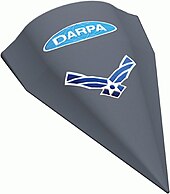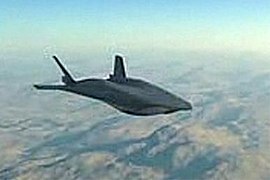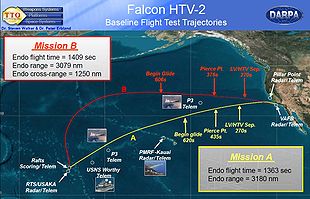
The Defense Advanced Research Projects Agency (DARPA) is a research and development agency of the United States Department of Defense responsible for the development of emerging technologies for use by the military.

The Boeing X-20 Dyna-Soar was a United States Air Force (USAF) program to develop a spaceplane that could be used for a variety of military missions, including aerial reconnaissance, bombing, space rescue, satellite maintenance, and as a space interceptor to sabotage enemy satellites. The program ran from October 24, 1957, to December 10, 1963, cost US$660 million, and was cancelled just after spacecraft construction had begun.

The NASA X-43 was an experimental unmanned hypersonic aircraft with multiple planned scale variations meant to test various aspects of hypersonic flight. It was part of the X-plane series and specifically of NASA's Hyper-X program developed in the late 1990s. It set several airspeed records for jet aircraft. The X-43 is the fastest jet-powered aircraft on record at approximately Mach 9.6.

The Boeing X-51 Waverider is an unmanned research scramjet experimental aircraft for hypersonic flight at Mach 5 and an altitude of 70,000 feet (21,000 m). The aircraft was designated X-51 in 2005. It completed its first powered hypersonic flight on 26 May 2010. After two unsuccessful test flights, the X-51 completed a flight of over six minutes and reached speeds of over Mach 5 for 210 seconds on 1 May 2013 for the longest duration powered hypersonic flight.
Scramjet programs refers to research and testing programs for the development of supersonic combustion ramjets, known as scramjets. This list provides a short overview of national and international collaborations, and civilian and military programs. The USA, Russia, India, and China (2014), have succeeded at developing scramjet technologies.

Lockheed L-301 was an experimental air-breathing hypersonic aircraft project. It was developed by the NASA and United States Air Force (USAF) organization National Hypersonic Flight Research Facility, with Skunk Works as the prime contractor. In January 1977, the program was "tentatively scheduled to operate two vehicles for eight years and to conduct 100 flights per vehicle." NASA discontinued work on L-301 and NHRF in September 1977 due to budget constraints and lack of need.

Hypersonic flight is flight through the atmosphere below altitudes of about 90 km at speeds greater than Mach 5, a speed where dissociation of air begins to become significant and high heat loads exist. Speeds over Mach 25 have been achieved below the thermosphere as of 2020.

USA-212 was the first flight of the Boeing X-37B Orbital Test Vehicle 1, an American robotic vertical-takeoff, horizontal-landing (VTHL) spaceplane. It was launched aboard an Atlas V rocket from Cape Canaveral on 22 April 2010, and operated in low Earth orbit. Its designation is part of the USA series.
Conventional Prompt Strike (CPS), formerly called Prompt Global Strike (PGS), is a United States military effort to develop a system that can deliver a precision-guided conventional weapon strike anywhere in the world within one hour, in a similar manner to a nuclear ICBM. Such a weapon would allow the United States to respond far more swiftly to rapidly emerging threats than is possible with conventional forces. A CPS system could also be useful during a nuclear conflict, potentially replacing the use of nuclear weapons against up to 30% of targets. The CPS program encompasses numerous established and emerging technologies, including conventional surface-launched missiles and air- and submarine-launched hypersonic missiles, although no specific CPS system has yet been finalized as of 2018.
HyShot is a research project of The University of Queensland, Australia Centre for Hypersonics, to demonstrate the possibility of supersonic combustion under flight conditions using two scramjet engines, one designed by The University of Queensland and one designed by QinetiQ.
The Reusable Booster System (RBS) was a United States Air Force research program, circa 2010 to 2012, to develop a new prototype vertical-takeoff, horizontal-landing (VTHL) reusable booster and a new prototype expendable second stage to replace the existing Evolved Expendable Launch Vehicles (EELV) after 2025. The program was discontinued in 2012.

Hypersonic Technology Vehicle 2 (HTV-2) is an experimental hypersonic glide vehicle developed as part of the DARPA Falcon Project designed to fly in the Mach 20 range. It is a test bed for technologies to provide the United States with the capability to reach any target in the world within one hour using an unmanned hypersonic bomber aircraft.
The DARPA XS-1 was an experimental spaceplane/booster with the planned capability to deliver small satellites into orbit for the U.S. Military. It was reported to be designed to be reusable as frequently as once a day, with a stated goal of doing so for 10 days straight. The XS-1 was intended to directly replace the first stage of a multistage rocket by taking off vertically and flying to hypersonic speed and high suborbital altitude, enabling one or more expendable upper stages to separate and deploy a payload into low Earth orbit. The XS-1 would then return to Earth, where it could ostensibly be serviced fast enough to repeat the process at least once every 24 hours.

The Lockheed Martin SR-72, colloquially referred to as "Son of Blackbird", is an American hypersonic UAV concept intended for intelligence, surveillance and reconnaissance (ISR) proposed privately in 2013 by Lockheed Martin as a successor to the retired Lockheed SR-71 Blackbird. In 2018, company executives said an SR-72 test vehicle could fly by 2025 and enter service in the 2030s.

Non-ballistic atmospheric entry is a class of atmospheric entry trajectories that follow a non-ballistic trajectory by employing aerodynamic lift in the high upper atmosphere. It includes trajectories such as skip and glide.

The Avangard is a Russian hypersonic glide vehicle (HGV) that can be carried as an MIRV payload by the UR-100UTTKh, R-36M2 and RS-28 Sarmat heavy ICBMs. It can deliver both nuclear and conventional payloads. The Avangard is reportedly capable of travelling at re-entry speeds.

A hypersonic weapon is a weapon capable of travelling at hypersonic speed, defined as between 5 and 25 times the speed of sound or about 1 to 5 miles per second.

The AGM-183 ARRW is a hypersonic air-to-ground ballistic missile planned for use by the United States Air Force. Developed by Lockheed Martin, the boost-glide vehicle is propelled to a maximum speed of more than Mach 5 by a rocket motor before gliding toward its target. The program was cancelled in March 2023 after multiple failed tests. The program, however, continued despite the cancellation and was announced to still be in development following additional, undisclosed testing.

The Hypersonic Air-breathing Weapon Concept is a scramjet powered hypersonic air-launched cruise missile project at the U.S. Defense Advanced Research Projects Agency (DARPA), that had a successful hypersonic flight announced in September 2021. It is a kinetic energy weapon, without an explosive warhead.
SCIFIRE, or the Southern Cross Integrated Flight Research Experiment, is an American-Australian military technology partnership that is developing a solid-rocket-boosted, air-breathing, hypersonic conventional cruise missile that can be launched by existing fighter or bomber aircraft.



















